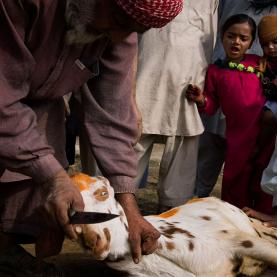Ritual slaughter
In Islam, the practice of ritual slaughter fulfils a set of conditions which ensure that the meat is halal, or edible. Set out in the Quran, it is more than just a simple religious ritual. A thriving social practice which has evolved through history, it is the focus of current-day ethical and legislative debates concerning animal welfare. The impacts are even felt on individual choices with regard to the act of eating as an act of faith and as a symbol of belonging to a community.
Emergence in France
In France, the history of halal ritual slaughter is closely linked to its Jewish equivalent, Shechita. In the 1960s, the first Muslim immigrants from North Africa initially bought their meat from Jewish kosher butchers, as the Quran authorises the consumption of meat produced by ‘People of the Book’ (Jews and Christians). As the immigrants settled and became more affluent, demand for halal meat increased. This resulted in the development of specialist butchers, and, from the end of the 1970s, the industrialisation of the practice which is now more or less regulated by food certification standards.
Conditions and methods of the ritual slaughter
Although less restrictive than the Jewish Shechita, Muslim ritual slaughter must meet certain conditions and be carried out using specific techniques in order for the meat to be declared lawful for consumption. The death of the animal must be intentional, supervised and controlled. A sacrificer who, if he is not Muslim, must belong to the ‘People of the Book’, uses a sharp blade to kill the animal by slitting its throat. The choice of instrument is of little importance, it is the technique that counts as the throat (the jugular, tracheal artery and oesophagus) must be slit in one movement. Decapitation is not recommended but tolerated, while slaughtering the animal across the back of the neck is forbidden. The technique differs depending on the size and type of animal. In the case of farm animals, nahr (stabbing the knife into the bottom of the throat) is recommended for large livestock and dabh (slicing the throat) for smaller animals. Other methods of slaughter, such as aqh (hunting with a gun) are reserved for wild game. Lying the animal on its left side facing Mecca is optional, as is pronouncing God’s name. However, the animal must be alive and its death must result from the blood draining from its veins for its meat to be halal.
Stunning the animal and secular legislation
The animal must be alive at the moment of slaughter. This condition raises questions surrounding the stunning of the animal before its death. Concerns for animal welfare lie at the centre of legislation in secular countries regulating the slaughter of animals for meat and poultry. From the Muslim point of view, the ritual of immolation is considered as ‘bloody, but fair’, respectful of the sacrificed animal. However, current legislation in Western countries is not aligned on this point. Three main trends prevail: religious slaughter without prior stunning authorised, but stunning imposed after bleeding (United Kingdom, Estonia, Slovakia, Finland, Denmark, New Zealand); slaughter without stunning prohibited (Latvia, Sweden and Switzerland); slaughter without stunning authorised (France, Belgium, Germany, etc.). In the latter case, for the slaughter to be legal, it may be subject to other conditions such as obtaining a permit, veterinary supervision, specific methods for restraining the animal (United Kingdom, Netherlands), or specific techniques for throat-cutting and bleeding.
Point of view of young Muslims
Concern for animal welfare is now leading younger generations and descendants of Muslim immigrants to adopt a vegetarian or pescetarian diet compatible with halal precepts. They are thereby distancing themselves from their parents’ culinary and food traditions.
MASSON, Denise. (trad.), 1967. Coran. Paris : Gallimard.
ASSOULY, Olivier, 2002. Les nourritures divines. Essai sur les interdits alimentaires. Paris : Actes Sud.
BENKHEIRA, Hocine, 1995. La nourriture carnée comme frontière rituelle. Les boucheries musulmanes en France. Archives des Sciences sociales des religions. 1995. N° 92, pp. 67-88.
BENKHEIRA, Hocine, 1998. Sanglant mais juste : l’abattage en islam. Etudes rurales. 1998. N°147-148, pp. 65-79.
BERGEAUD-BLACKLER, Florence, BERNARD, Bruno, 2010. Comprendre le halal. Guide pratique. Liège : Edi Pro.
RODIER, Christine, 2014. La question halal. Sociologie d’une consommation controversée. Paris : PUF.
UNGER, Gérard et al. (dir.), s.d. Les rituels alimentaires des principales religions. Influencent-ils encore notre alimentation en France ?, Première table ronde [en ligne]. [Consulté le 03 août 2015]. Disponible à l’adresse : http://www.lemangeur-ocha.com
VIALLES, Noëlie, 1998. Toute chair n’est pas viande. Etudes rurales. 1998. N° 147-148, pp. 139-149.










